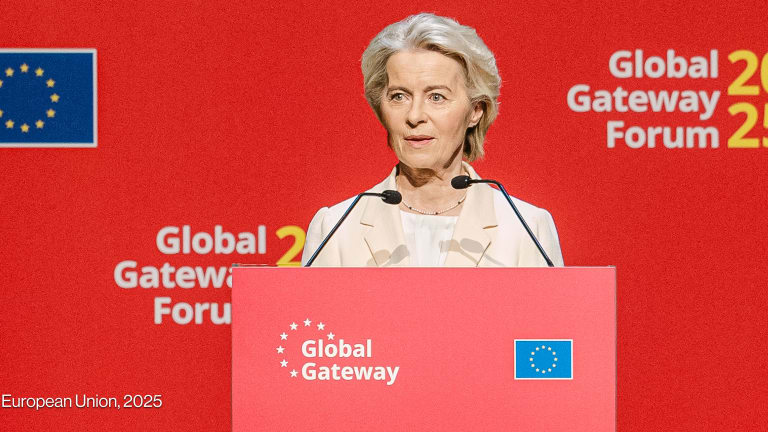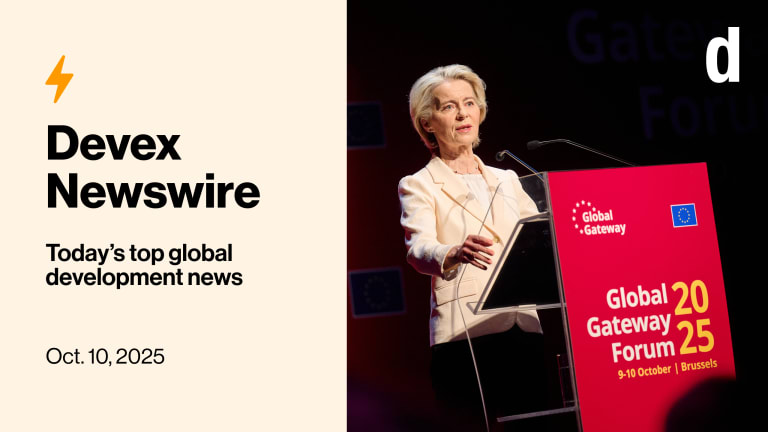What is the EU's 'Global Gateway' anyway?
The European Development Days provided ample opportunity to learn more about the European Commission's "Global Gateway" — including who will decide some big questions and whether any additional money will back it.
This year’s European Development Days were a chance to talk about whether the European Commission’s new “Global Gateway” investment strategy is a Belt-and-Road-rivaling gamechanger, or just preexisting money and “heroic assumptions.” In the face of the skeptics, the medium is the message. After years of calls from pundits and the European Union’s own member states to boost the reputational return on the EU’s combined annual development spend of almost €70 billion ($73.7 billion), one of the commission’s internal targets this year is to see 100 media articles on the Global Gateway concept. To wit … Those looking to understand what the Gateway is in theory have the December 2021 policy that promises a “values-driven” infrastructure strategy that will “mobilize” €300 billion in investments by 2027. Those looking to understand what it means in practice came to the EDDs, held in a hybrid format near Brussels’ famous Atomium this week, hoping for answers. Is there any additional money? The temperature rose Tuesday when Reinhard Bütikofer, a German Greens member of the European Parliament, told Jean-Letitia Saldanha, the director of Eurodad, a European NGO network working on debt and development, that she had not done her homework when she referred to a lack of transparency over the Gateway and how it would be funded. Bütikofer said during the session that the Gateway is more than repackaged funds, and told Devex afterward that he sees three sources of new money: from the EU budget, member states, and the private sector. The last two are aspirational for now. Regarding the private sector, as it has since 2017, the commission is offering budget guarantees to mostly European development banks’ to encourage them to invest in low- and middle-income countries in the hope that this will crowd in private investment. Its initial attempt has so far failed to impress the European Court of Auditors. Now it is trying again. French, German, and Spanish lenders, European multilateral development banks, but also smaller players like Poland’s BGK, and non-Europeans like the International Finance Corporation, are preparing to submit their proposals by mid-July. Regarding EU states, the commission has been making frequent calls for them to contribute to so-called Team Europe Initiatives — the plans underpinning the Gateway, steered by Brussels, where the commission and EU countries spend in similar sectors and regions to improve their collective impact and renown. As for the EU budget, the financial firepower for the Gateway is largely based on the commission’s 2021-2027 instrument for external spending, agreed last summer after three years of negotiations. At the start of a new seven-year budget cycle, some commission staff argues that does constitute new money. A rare novelty, buried in a footnote in the December policy, is a strengthened role for the European Investment Bank. If that has been underplayed in the public messaging to date, however, that could be because the likes of German bank KfW were calling for any top up in guarantee capacity from the commission to be made available to all European financial institutions. Having lost that battle, KfW turned the other cheek, telling Devex in March that “we consider [the Gateway] initiative to be a joint Team Europe effort, not a competition.” What about the Sustainable Development Goals? The EU commissioner for international partnerships, Jutta Urpilainen, referred to the Gateway this week as a “strategy” and a “framework.” The question development banks and NGOs are asking themselves is what fits in the frame? The Gateway policy mentions digitalization, health, climate, energy, transport, and education and research. Even sectors such as agriculture and water feature in the EU-Africa: Global Gateway Investment Package released at a summit with the African Union in February. Those who arrived at the EDDs wondering what the Gateway is could be forgiven for leaving wondering what it is not. Tanya Cox, the director of CONCORD, the confederation of European development NGOs, told Devex that organizers excluded civil society from the main panel discussions this week, and that “civil society is instead left waiting to hear how the Global Gateway will reach the most marginalised.” That concern reflects a larger debate. Michele Cervone d’Urso, the head of international cooperation and financing instruments at the European External Action Service, told the European Parliament earlier this year that the Gateway is “beyond development aid” though the Sustainable Development Goals are “at the forefront of everything we do.” Squaring that logic could be helped by the OECD’s Development Assistance Committee in Paris. The 30-member body, which includes the European Union, sets the rules on what counts as official development assistance. Its chair Susanna Moorehead told Devex in April that she is working to agree on permanent rules on how to count the contribution of private sector instruments, such as loans and guarantees. Until then, the DAC, and its members, will continue to face the criticism, leveled in the Financial Times last week, that aid statistics are not credible. Who decides what? The December policy mentions a Global Gateway Board and a Business Advisory Group, though the commission and EU states are still hashing out the details. Not everyone in the commission is convinced that creating a new board to offer strategic guidance would be very strategic. The European Fund for Sustainable Development-plus, which oversees the budget guarantees, already has a steering board — albeit one from which the European Bank for Reconstruction and Development and the Association of European Development Finance Institutions are excluded because of their non-EU members. At the same time, Commission President Ursula von der Leyen said Tuesday in her video message that “Global Gateway is open for cooperation with any country that shares our goals,” naming “friends” such as Japan, India, and the United States — which is laboring to get its own global infrastructure initiative off the ground. It’s not clear what such cooperation would mean in practice. How is it playing in the rest of the world? “In Latin America, many people ask, ‘is this an attempt at containing the Belt and Road initiative, for example?” Bárbara Carvalho Neves, a PhD student from Brazil, told Devex after a panel on the Gateway in Latin America and the Caribbean. “So we have many questions: What is this? What does the European Union want from this?” “In a political way, I see an initiative from the European Union to go back into its role in global governance,” she said. “To come back and start acting again, especially for the 2030 Agenda.” For Ibrahim Ameer, finance minister of the Maldives, more needs to be done to launch the concept of the Gateway internationally. “More people need to know what we are doing with the European Development Days,” he told Devex as he signed an €18.4 million EIB loan to support his country’s health sector. “There needs to be more engagement with the developing countries.” Overall the two-day event felt more subdued than pre-pandemic editions when YouTube influencers would give frenetic pop-up performances and former leaders like Tony Blair would fill breakout rooms before tearing back to the sanctuary of the VIP area. Reflections are already afoot for a possible Global Gateway forum later in the year — though it feels like we just had it.
This year’s European Development Days were a chance to talk about whether the European Commission’s new “Global Gateway” investment strategy is a Belt-and-Road-rivaling gamechanger, or just preexisting money and “heroic assumptions.” In the face of the skeptics, the medium is the message. After years of calls from pundits and the European Union’s own member states to boost the reputational return on the EU’s combined annual development spend of almost €70 billion ($73.7 billion), one of the commission’s internal targets this year is to see 100 media articles on the Global Gateway concept. To wit …
Those looking to understand what the Gateway is in theory have the December 2021 policy that promises a “values-driven” infrastructure strategy that will “mobilize” €300 billion in investments by 2027. Those looking to understand what it means in practice came to the EDDs, held in a hybrid format near Brussels’ famous Atomium this week, hoping for answers.
The temperature rose Tuesday when Reinhard Bütikofer, a German Greens member of the European Parliament, told Jean-Letitia Saldanha, the director of Eurodad, a European NGO network working on debt and development, that she had not done her homework when she referred to a lack of transparency over the Gateway and how it would be funded.
This story is forDevex Promembers
Unlock this story now with a 15-day free trial of Devex Pro.
With a Devex Pro subscription you'll get access to deeper analysis and exclusive insights from our reporters and analysts.
Start my free trialRequest a group subscription Printing articles to share with others is a breach of our terms and conditions and copyright policy. Please use the sharing options on the left side of the article. Devex Pro members may share up to 10 articles per month using the Pro share tool ( ).
Vince Chadwick is a contributing reporter at Devex. A law graduate from Melbourne, Australia, he was social affairs reporter for The Age newspaper, before covering breaking news, the arts, and public policy across Europe, including as a reporter and editor at POLITICO Europe. He was long-listed for International Journalist of the Year at the 2023 One World Media Awards.








